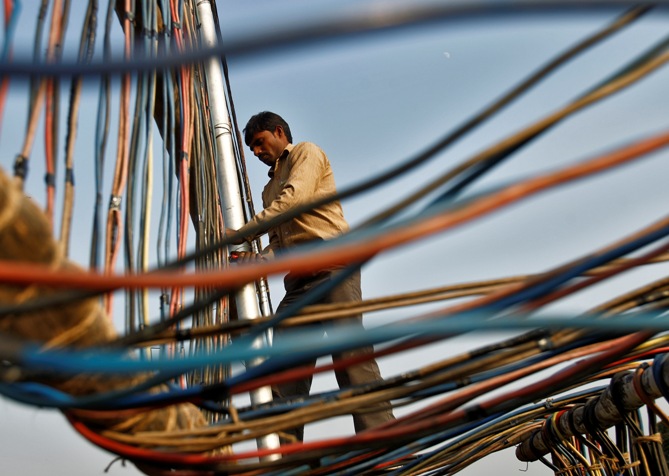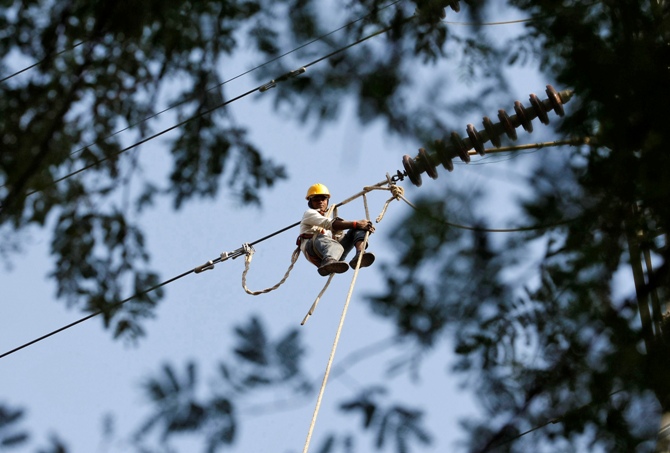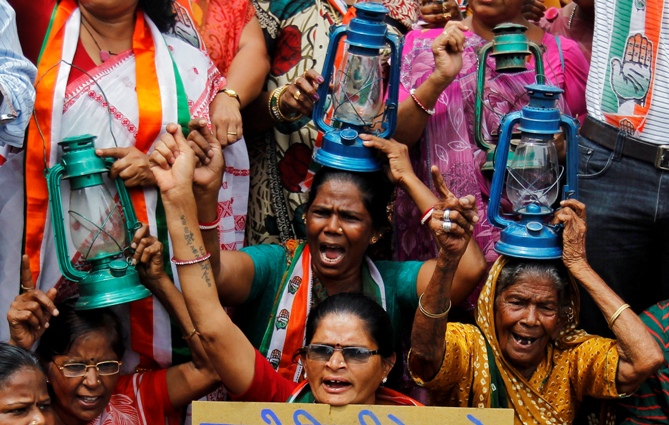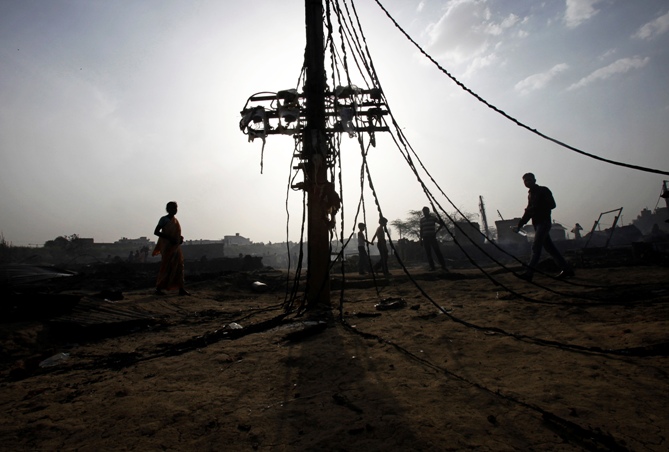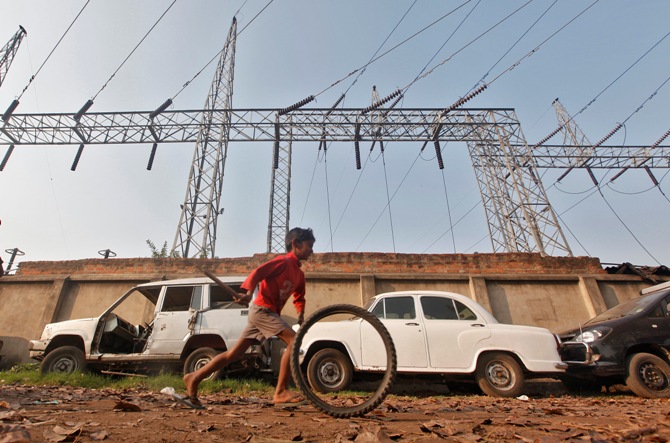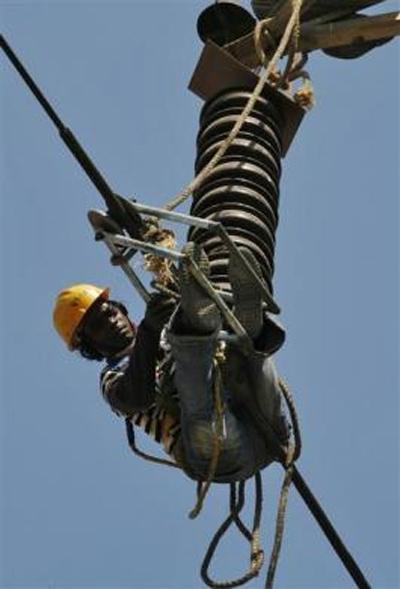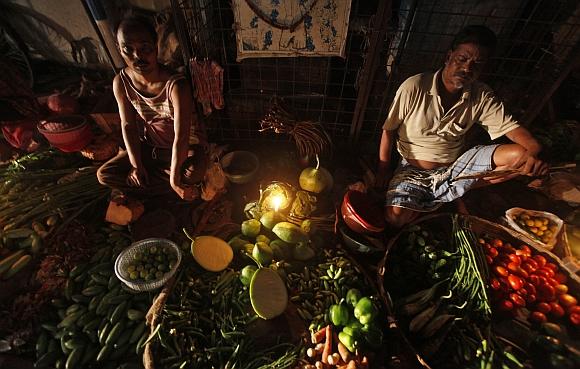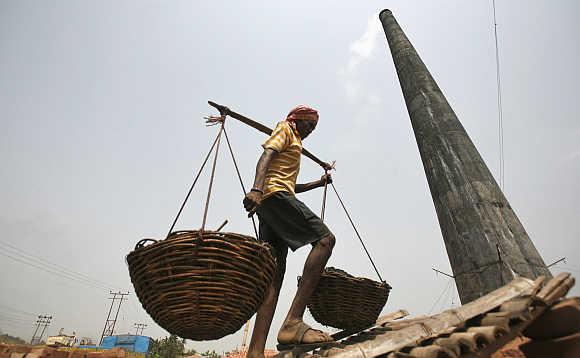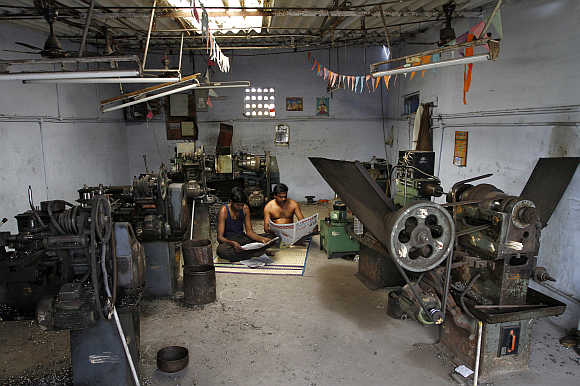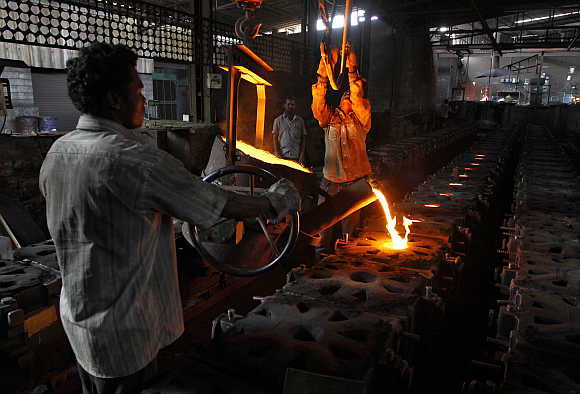 | « Back to article | Print this article |
'Political meddling is at the root of India's power problems'
More than 10 per cent of India's electricity demand routinely goes unmet at peak periods, according to the country's Central Electricity Authority, rues John Kemp.
For decades, India's power engineers had a dream: "One Nation. One Grid. One Frequency."
At the start of this year, that vision was realised.
India finally has a nationwide power system stretching from Tamil Nadu in the south to Kashmir in the north, Gujarat in the west to Nagaland in the east.
On December 31, India commissioned the last link, a high-voltage transmission line between Raichur and Solapur, connecting the southern regional grid to the four other grids serving the north, east, west and northeast, which had been successively integrated since 1991.
Click NEXT to read further. . .
'Political meddling is at the root of India's power problems'
The whole of India's electricity system was synchronised and started to function as one giant machine.
Unification is a powerful symbol of national identity and modernisation as well as enabling the system to operate more efficiently.
Britain's seven regional networks were first synchronised as long ago as 1937 in an unauthorised night-time experiment by electrical controllers and officially integrated in the winter of 1938.
Until then, ‘having too many power stations connected together in one big network had been thought too risky’, according to the Central Electricity Generating Board.
But the national grid kept Britain's armaments factories running during the heavy air raids of World War Two.
Click NEXT to read further. . .
'Political meddling is at the root of India's power problems'
The United States integrated almost its entire network into two giant interconnections that link into neighbouring parts of Canada and Mexico: the Eastern Interconnection in 1962 and the Western Interconnection in 1967.
China, too, is rapidly linking its regional grid operations into a nationwide super-grid.
But India's belated arrival in the super-grid club cannot disguise the underdevelopment of the country's electricity system.
Unmet demand
More than 300 million people in India lack access to electricity, according to the World Bank and the International Energy Agency, compared with fewer than 3 million in China.
In 2012/13, India's power system was able to supply a peak of just 124,000 megawatts for a country of more than 1.2 billion people.
By contrast, Britain's power stations generated a maximum of 55,000 megawatts for a country of 60 million.
Click NEXT to read further. . .
'Political meddling is at the root of India's power problems'
On average, Indians consume 917 kilowatt-hours each per year compared with 3,300 in China, 5,400 in Britain and 13,000 in the United States.
India has just over 1 million km (625,000 miles) of high-voltage transmission circuits and 185 substations.
That compares with around 750,000 circuit-kilometres on the main interconnections in North America, which has a population a quarter the size of India's, and more than 50,000 transformer substations in the United States alone.
Generation is dominated by old and inefficient coal-fired units that belch soot, toxic pollutants and carbon dioxide.
Coal accounts for 60 per cent of India's installed generation capacity with some hydro (16 per cent) and renewables (13 per cent) as well as smaller amounts of natural gas and nuclear.
Power cuts are frequent as demand often outstrips supply.
More than 10 per cent of electricity demand routinely goes unmet at peak periods, according to India's Central Electricity Authority (‘Annual Report 2012-13’).
Click NEXT to read further. . .
'Political meddling is at the root of India's power problems'
Power failures
India's grid has proved worryingly unmanageable and unstable -- even before the synchronisation of a fifth region with hundreds of millions more customers.
In July and August 2012, India's two worst blackouts in history cascaded across the north and the east, cutting electricity to states and territories home to more than half of the country's population.
Ironically, the only region spared was the southern one because it was not synchronised with the rest of the grid.
The lack of direct connection served as a firebreak as blackouts rippled across the network, the danger foreseen by Britain's grid engineers in the 1920s and 1930s.
Blackouts occurred because during the intense summer heat, which stretched the country's generation and transmission resources to the limit, many of India's state electricity boards ignored instructions to reduce power deliveries to their customers.
A cascading failure resulted.
Click NEXT to read further. . .
'Political meddling is at the root of India's power problems'
But it is not just too much consumption that can destabilise the grid.
Last month, the northern grid collapsed when thunderstorms and heavy rain hit Delhi, Uttar Pradesh, Haryana and Uttarakhand.
Bad weather caused a sudden reduction in demand.
As voltage and frequency surged, 69 high-voltage transmission lines disconnected themselves to protect equipment.
Around 8,000 megawatts of load was dumped in half an hour, equivalent to 6 per cent of India's power supply, including 3,500 megawatts in Delhi, according to a report prepared by the Central Electricity Authority (‘Report on the Load Crash in Northern Grid during the evening of 30th May 2014’).
Cascading power failures are not unique to India.
The United States, Canada, Brazil and Indonesia have suffered partial grid collapses.
But the frequency with which India's grid has lost control is a cause of concern.
Click NEXT to read further. . .
'Political meddling is at the root of India's power problems'
Power politics
The fundamental problem in India's electricity industry is political.
The industry is fragmented between a relatively weak Central Electricity Authority and Power Grid of India, which manage the network, and strong state electricity boards that answer to local politicians.
The boards control regional distribution and generation.
Prices have been strictly controlled, and in many areas cheap electricity and the promise of connection have been used as a political tool.
Subsidisation, especially for farmers, and non-payment of electricity bills are endemic.
The result is that Indians pay too little for electricity. Those who have access often use it wastefully while millions more have no access at all.
There are not enough revenues to support the massive building programme needed to connect all of India's villages, build new transmission lines and construct extra power plants.
Click NEXT to read further. . .
'Political meddling is at the root of India's power problems'
India needs hundreds of new power plants (including wind farms and solar power stations) coupled with investment in more transmission capacity, significant improvements in grid stability control, and a massive rural electrification programme comparable to the one that brought power to rural America in the 1930s and 1940s.
Such an enormous investment programme will be forthcoming only if prices are raised high enough to cover the cost of generation and transmission and provide investors with a realistic rate of return.
There will still need to be an element of subsidisation (either from customer bills or taxation) to cover the cost of linking villages to the network.
But once customers are connected, they should pay the full cost of transmission and generation.
Click NEXT to read further. . .
'Political meddling is at the root of India's power problems'
Reform prospects
There have been price increases in recent years.
The average power tariff in Maharashtra has been raised to around 15 US cents per kilowatt-hour, which is comparable to much of the United States.
But in much of India the price is less than half this level. Customers in populous but power-short Uttar Pradesh and Bihar pay just 8 cents per kilowatt-hour ("An analysis of power tariffs across India", February 2013).
The electricity system needs much more centralisation.
It is too easy for state electricity boards to obstruct realistic pricing and grid management. The synchronisation of regional grids must be accompanied by more integration of electricity suppliers.
"Current problems are the result not just of bureaucracy but of the fragmentation of the distribution process," according to Nick Butler, chair of the King's Policy Institute in London.
Click NEXT to read further. . .
'Political meddling is at the root of India's power problems'
India's new prime minister "will have to centralise decision-making", Butler wrote recently in the Financial Times ("Indian power: Modi must centralise it", June 1).
Gujarat, the state formerly run by new Prime Minister Narendra Modi, has been touted for its efficient and commercially run electricity industry, which featured in the recent national election campaign.
Since 2003, power thefts have been slashed.
The state separated agricultural and residential power systems.
Rural homes pay higher bills but get more reliable power supply.
"Gujarat now supplies near 24-hour electricity not only to its large cities and towns but to the 18,000 villages too," according to the Times of India.
During recent power shortages, Gujarat has been selling its surplus power to neighbouring Rajasthan, Haryana and Delhi (‘Power-full Gujarat gives 24-hour electricity’, March 4, 2013).
Gujarat's well-run electricity system could be a model for the rest of the country.
But first, India needs to sweep away the entrenched interests in the state electricity boards and shift to a full cost-recovery model.

© Copyright 2025 Reuters Limited. All rights reserved. Republication or redistribution of Reuters content, including by framing or similar means, is expressly prohibited without the prior written consent of Reuters. Reuters shall not be liable for any errors or delays in the content, or for any actions taken in reliance thereon.
